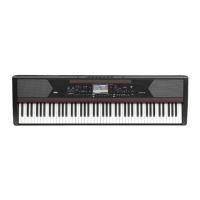Introduction to MIDI |663
44 MIDI
Introduction to MIDI
Ports, channels, messages
What is MIDI?
MIDI stands for Musical Instruments Digital Interface. This interface lets
you connect two musical instruments, or a computer and various musical
instruments.
From a software point of view, MIDI is a protocol that describes messages for
playing notes and controlling them. It is sort of a grammar to let different
instruments and computers speak the same language, and let the one tell
the other what to do.
From a physical point of view, MIDI messages travel across the USB DEVICE
port, a modern connector replacing the MIDI ports found in older musical
instruments with a single port and cable. Havian 30 can be connected to a
Windows or Mac computer with no need of special software. However, for full
and easy use of all its MIDI features, we suggest that you install the KORG
USB MIDI Driver, a special software that you can find in the Accessory Disc,
or can download from our web site (www.korg.com).
Channels and messages
Basically, a MIDI or USB cable transmits 16 channels of data. Think to each
MIDI channel as a TV channel: the receiver must be set on the same channel
of the transmitter. The same happens with MIDI messages: when you send
a Note On message on channel 1, it will be received on channel 1 only. This
allows for multitimbricity: you can have more than one sound playing on the
same MIDI instrument.

